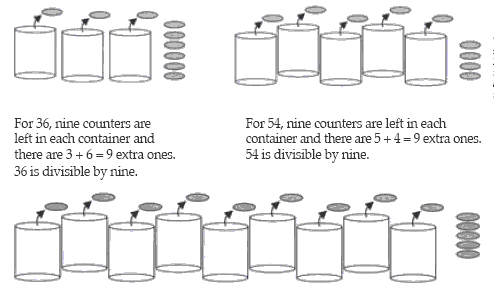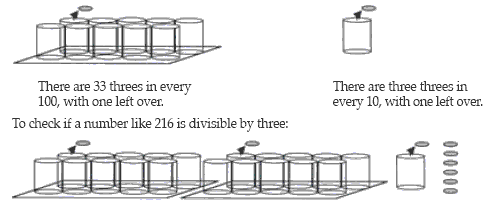Ask the students to give you four different numbers that they know are in the nine times tables, for example, 27, 36, 54, 81. Make these numbers with place value material.
Tell the students that when a number is a multiple of nine, we say that it is “divisible by nine”. Point out that the learning outcome they are looking for is a pattern that will help them tell if a number is divisible by nine without doing the division.
Ask, “How many nines do you get in 10?” (One set of nine with one left over.)With the models of 36 and 54, etc., look at why these numbers are divisible by nine:

For 95, after putting nine counters in each container, the left over ones total9 + 5 = 14 (sum of the digits in 95). 14 is not divisible by nine.
Extend this idea to three-digit numbers, like 234, that are divisible by nine. Ask,“How many nines do you get in 100?” (11 nines with one left over.)
Use blank tens frames with bean canisters placed on all 10 spaces to form hundreds.Make the numbers and fi nd out whether or not they are divisible by nine.

For 234, 99 are left in every hundred, nine are left in every 10, and the extra ones total 2 + 3 + 4 = 9 (sum of the digits), so 234 is divisible by nine.
Model other three-digit numbers with materials, for example, 306, 576, 444. Find out if these numbers are divisible by nine. Look for the students to realise that the sum of the digits tells how many extra ones are available.

Using Imaging
Pose problems about divisibility by nine but mask the materials under plastic ice cream containers. Extend the students’ thinking to include how many nines there must be in the number, and for numbers that are not divisible by nine, what the remainder after division by nine would be. Good examples are:
“Which of these numbers is divisible by nine?”
321 (3 + 2 + 1 = 6, so no), 279 (2 + 7 + 9 = 18, so yes), 198 (1 + 9 + 8 = 18, so yes),426 (4 + 2 + 6 = 12, so no), 295 (2 + 9 + 5 = 16, so no), 997 (9 + 9 + 7 = 25, so no).
For each number ask, “ How many nines are in each number?”
With 279, there are 2 _ 11 = 22 nines in the hundreds, 7 nines in the tens, and 2 nines in the extra ones. That is a total of 22 + 7 + 2 = 31.
For each number that is not divisible by nine, ask, “What is the remainder when you divide [number] by nine?”
With 295, the extra ones total 2 + 9 + 5 = 16, 16 ÷ 9 = 1 remainder 7, so the remainder when 295 is divided by nine is seven.
Fold back to the materials if the students have difficulty imaging, particularly withthe “How many nines?” and, “What is the remainder?” questions.
After sufficient examples, ask the students, “How could we use this same idea to find out if a number is divisible by three?” Some students may be able to generalise this idea.
.gif)
Taking one from each 100 and one from the 10 gives 2 + 1 + 6 = 9 extra ones.
Since nine is divisible by three, 216 is divisible by three.
Get the students to check other numbers for divisibility by three, folding back to the
materials if necessary.
Using Number Properties
The students will show understanding of the number properties if they can solve
the following problems mentally.
“For each number below decide:
Is it divisible by nine?
Is it divisible by three?
How many nines and threes are in the number?
What is the remainder when the number is divided by nine and three?”
852 1 008 666 2 074 5 688 6 251
Ask, “Can a number be divisible by nine but not be divisible by three?” (No) and
“Can a number be divisible by three but not be divisible by nine?” (Yes, e.g., 24)

.gif)

